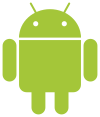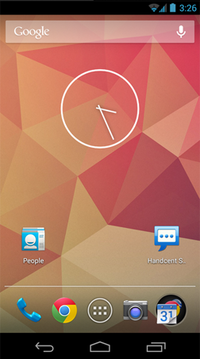Android (operating system)

From Wikipedia, the free encyclopedia

Android 4.3 (Jelly Bean) on Samsung Galaxy Nexus
| |
| Company / developer | Google Open Handset Alliance Android Open Source Project (AOSP) |
|---|---|
| Programmed in | C (core), C++,Java (UI)[1] |
| OS family | Unix-like |
| Working state | Current |
| Source model | Open-source[2] (with proprietary drivers) |
| Initial release | September 23, 2008[3] |
| Latest stable release | 4.3 Jelly Bean / August 23, 2013[4] |
| Marketing target | Smartphones Tablet computers |
| Available language(s) | Multi-lingual (46 languages) |
| Package manager | Google Play, APK |
| Supported platforms | ARM, MIPS,[5] x86[6] |
| Kernel type | Monolithic (modified Linux kernel) |
| Userland | Bionic libc,[7] shellfrom NetBSD,[8] native core utilities with a few from NetBSD[9] |
| Default user interface | Graphical (Multi-touch) |
| License | Apache License 2.0 Linux kernel patches under GNU GPL v2[10] |
| Official website | www.android.com |
Android is a Linux-based operating system[11] designed primarily for touchscreen mobile devices such as smartphones and tablet computers. Initially developed by Android, Inc., which Google backed financially and later bought in 2005,[12] Android was unveiled in 2007 along with the founding of the Open Handset Alliance: a consortium of hardware, software, and telecommunication companies devoted to advancing open standards for mobile devices.[13] The first Android-powered phone was sold in October 2008.[14]
Android is open source and Google releases the code under the Apache License.[11] This open-source code and permissive licensing allows the software to be freely modified and distributed by device manufacturers, wireless carriers and enthusiast developers. Additionally, Android has a large community of developers writing applications ("apps") that extend the functionality of devices, written primarily in a customized version of theJava programming language.[15] In October 2012, there were approximately 700,000 apps available for Android, and the estimated number of applications downloaded from Google Play, Android's primary app store, was 25 billion.[16][17] A developer survey conducted in April–May 2013 found that Android is the most popular platform for developers, used by 71% of the mobile developer population.[18]
These factors have contributed towards making Android the world's most widely used smartphone platform,[19] overtaking Symbian in the fourth quarter of 2010,[20] and the software of choice for technology companies who require a low-cost, customizable, lightweight operating system for high tech devices without developing one from scratch.[21]As a result, despite being primarily designed for phones and tablets, it has seen additional applications on televisions, games consoles, digital cameras and other electronics. Android's open nature has further encouraged a large community of developers and enthusiasts to use the open-source code as a foundation for community-driven projects, which add new features for advanced users[22] or bring Android to devices which were officially released running other operating systems.
Android's share of the global smartphone market, led by Samsung products, was 64% in March 2013.[23] In July 2013 there were 11,868 models of Android device, scores of screen sizes and eight OS versions simultaneously in use.[24] The operating system's success has made it a target for patent litigation as part of the so-called "smartphone wars" between technology companies.[25][26] As of May 2013, 48 billion apps have been installed from the Google Play store,[27][28] and as of September 3, 2013, 1 billion Android devices have been activated.[29]
Contents
[hide]History
See also: Android version history
Android, Inc. was founded in Palo Alto, California in October 2003 by Andy Rubin (co-founder of Danger),[30] Rich Miner (co-founder of Wildfire Communications, Inc.),[31] Nick Sears[32] (once VP at T-Mobile), and Chris White (headed design and interface development at WebTV)[12] to develop, in Rubin's words "smarter mobile devices that are more aware of its owner's location and preferences".[12] The early intentions of the company were to develop an advanced operating system for digital cameras, when it was realised that the market for the devices was not large enough, and diverted their efforts to producing a smartphone operating system to rival those of Symbian and Windows Mobile (Apple's iPhone had not been released at the time).[33]Despite the past accomplishments of the founders and early employees, Android Inc. operated secretly, revealing only that it was working on software for mobile phones.[12] That same year, Rubin ran out of money. Steve Perlman, a close friend of Rubin, brought him $10,000 in cash in an envelope and refused a stake in the company.[34]
Google acquired Android Inc. on August 17, 2005, making it a wholly owned subsidiary of Google. Key employees of Android Inc., including Rubin, Miner and White, stayed at the company after the acquisition.[12] Not much was known about Android Inc. at the time, but many assumed that Google was planning to enter the mobile phone market with this move.[12] At Google, the team led by Rubin developed a mobile device platform powered by the Linux kernel. Google marketed the platform to handset makers and carriers on the promise of providing a flexible, upgradable system. Google had lined up a series of hardware component and software partners and signaled to carriers that it was open to various degrees of cooperation on their part.[35][36][37]
Speculation about Google's intention to enter the mobile communications market continued to build through December 2006.[38]Reports from the BBC and the Wall Street Journal noted that Google wanted its search and applications on mobile phones and it was working hard to deliver that. Print and online media outlets soon reported rumors that Google was developing a Google-brandedhandset. Some speculated that as Google was defining technical specifications, it was showing prototypes to cell phone manufacturers and network operators. In September 2007, InformationWeek covered an Evalueserve study reporting that Google had filed several patent applications in the area of mobile telephony.[39][40]
On November 5, 2007, the Open Handset Alliance, a consortium of technology companies including Google, device manufacturers such as HTC, Sony and Samsung, wireless carriers such as Sprint Nextel and T-Mobile, and chipset makers such as Qualcomm and Texas Instruments, unveiled itself, with a goal to develop open standards for mobile devices.[13] That day, Android was unveiled as its first product, a mobile device platform built on the Linux kernel version 2.6.[13] The first commercially available phone to run Android was theHTC Dream, released on October 22, 2008.[41]
In 2010, Google launched its Nexus series of devices—a line of smartphones and tablets running the Android operating system, and built by a manufacturer partner. HTC collaborated with Google to release the first Nexus smartphone,[42] the Nexus One. The series has since been updated with newer devices, such as the Nexus 4 phone and Nexus 10 tablet, made by LG and Samsung respectively. Google releases the Nexus phones and tablets to act as their flagship Android devices, demonstrating Android's latest software and hardware features. On March 13, 2013, it was announced by Larry Page in a blog post that Andy Rubin had moved from the Android division to take on new projects at Google.[43] He was replaced by Sundar Pichai, who also continues his role as the head of Google's Chrome division,[44] which develops Chrome OS.
Since 2008, Android has seen numerous updates which have incrementally improved the operating system, adding new features and fixing bugs in previous releases. Each major release is named in alphabetical order after a dessert or sugary treat; for example, version 1.5 Cupcake was followed by 1.6 Donut. The latest released version is 4.3 Jelly Bean; however, version 4.4 KitKat was announced on September 3, 2013.[45][46]
0 comments:
Post a Comment